Guidelines
Coffin Grant Recipients
Jackson Prize Recipients
Place Maker Award Recipients
Place Keeper Award Recipients
Lifetime Achievement Award Recipients
The John Brinckerhoff Jackson Book Prize for 2017
The Foundation for Landscape Studies is pleased to announce the awardees of the 2017 John Brinckerhoff Jackson Book Prize for recently published books that have made significant contributions to the study and understanding of garden history and landscape studies. The recipients are listed in alphabetical order.
Pierre Bélanger and Alexander Arroyo
Ecologies of Power: Countermapping the Logistical Landscapes and Military Geographies of the U.S. Department of Defense
MIT Press, 2016
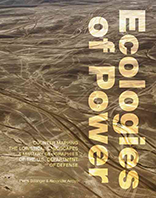 From the publisher:
From the publisher:
This book is not about war, nor is it a history of war. Avoiding the shock and awe of wartime images, it explores the contemporary spatial configurations of power camouflaged in the infrastructures, environments, and scales of military operations. Instead of wartime highs, this book starts with drawdown lows, when demobilization and decommissioning morph into realignment and prepositioning. It is in this transitional milieu that the full material magnitudes and geographic entanglements of contemporary militarism are laid bare. Through this perpetual cycle of build up and breakdown, the U.S. Department of Defense – the single largest developer, landowner, equipment contractor, and energy consumer in the world – has engineered a planetary assemblage of “operational environments” in which militarized, demilitarized, and non-militarized landscapes are increasingly inextricable.
In a series of critical cartographic essays, Pierre Bélanger and Alexander Arroyo trace this footprint far beyond the battlefield, countermapping the geographies of U.S. militarism across five of the most important and embattled operational environments: the ocean, the atmosphere, the highway, the city, and the desert. From the Indian Ocean atoll of Diego Garcia to the defense-contractor archipelago around Washington, D.C.; from the A01 Highway circling Afghanistan’s high-altitude steppe to surveillance satellites pinging the planet from low-earth orbit; and from the vast cold chain conveying military perishables worldwide to the global constellation of military dumps, sinks, and scrapyards, the book unearths the logistical infrastructures and residual landscapes that render strategy spatial, militarism material, and power operational. In so doing, Bélanger and Arroyo reveal unseen ecologies of power at work in the making and unmaking of environments – operational, built, and otherwise – to come.
Pierre Bélanger, a landscape architect and urbanist, is Associate Professor of Landscape Architecture at Harvard University’s Graduate School of Design and the coauthor of Ecologies of Power: Countermapping the Logistical Landscapes and Military Geographies of the U.S. Department of Defense (MIT Press) and Landscape as Infrastructure.
Alexander Arroyo is a doctoral student in Geography at the University of California, Berkeley.
Timothy Davis
National Park Roads: A Legacy in the American Landscape
The University of Virginia Press, 2016
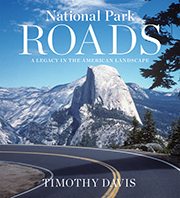 From the publisher:
From the publisher:
From Acadia and Great Smoky Mountains to Zion and Mount Rainier, millions of visitors tour America’s national parks. While park roads determine what most visitors see and how they see it, however, few pause to consider when, why, or how the roads they travel on were built. In this extensively researched and richly illustrated book, national parks historian Timothy Davis highlights the unique qualities of park roads, details the factors influencing their design and development, and examines their role in shaping the national park experience – from the Blue Ridge Parkway and Skyline Drive to Glacier National Park’s Going-to-the-Sun Road, Yellowstone's Grand Loop, Yosemite's Tioga Road, and scores of other scenic drives.
Decisions about park road development epitomize the central challenge of park management: balancing preservation and access in America’s most treasured landscapes. Park roads have been celebrated as technical and aesthetic masterpieces, hailed as democratizing influences, and vilified for invading pristine wilderness with the sights, sounds, and smells of civilization. Davis’s recounting of efforts to balance the interests of motorists, wilderness advocates, highway engineers, and other stakeholders offers a fresh perspective on national park history while providing insights into evolving ideas about the role of nature, recreation, and technology in American society.
Tales of strong personalities, imposing challenges, resounding controversies, and remarkable achievements enliven this rich and compelling narrative. Key players include many of the most important figures of conservation history – John Muir, Frederick Law Olmsted, wilderness advocates Aldo Leopold, Bob Marshall, and Ansel Adams, and NPS directors Stephen Mather and Horace Albright among them. An engrossing history, National Park Roads will be of interest to national park enthusiasts, academics, design professionals, resource managers, and readers concerned with the past, present, and future of this quintessentially American legacy. As the National Park Service celebrates its centennial, this book offers a fascinating and illuminating account of the agency’s impact on American lives and landscapes.
Timothy Davis, a historian with the U.S. National Park Service, has published and lectured widely on America’s national parks. He is the coeditor, with Todd Croteau and Christopher Marston, of America’s National Park Roads and Parkways: Drawings from the Historic American Engineering Record.
Elizabeth Kryder-Reid
California Mission Landscapes: Race, Memory, and the Politics of Heritage
University of Minnesota Press, 2016
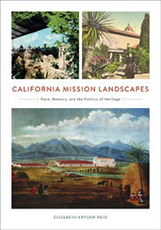 From the publisher:
From the publisher:
How iconic American places cultivate and conceal contested pasts California Mission Landscapes demonstrates how the gardens planted in mission courtyards over the last 150 years are not merely anachronistic but have become potent ideological spaces. Until now no book has explored the mission landscapes as an avenue into understanding the politics of the past, tracing the continuum between the Spanish colonial period, emerging American nationalism, and the contemporary heritage industry.
Elizabeth Kryder-Reid is professor of anthropology and museum studies and director of the Cultural Heritage Research Center in the Indiana University School of Liberal Arts (IUPUI) and former director of the IUPUI museum studies program.
Elizabeth Milroy
The Grid and the River: Philadelphia’s Green Places, 1682–1876
Pennsylvania State University Press, 2016
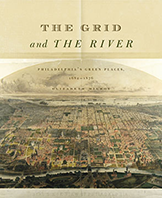 From the publisher:
From the publisher:
Philadelphians are fond of quoting a letter in which William Penn described his vision of a “greene country towne, which will never be burnt & always wholesome.” Today, Philadelphia’s public parks cover more than ten thousand acres – roughly 11 percent of the city’s area. They encompass extensive woodlands and waterways as well as the largest collection of historic properties in the state of Pennsylvania, including the Fairmount Water Works, the Philadelphia Zoo (the oldest zoo in the United States), and the Philadelphia Museum of Art.
The Grid and the River is the product of Elizabeth Milroy’s quest to understand the history of public green spaces in William Penn’s city. In this monumental work of urban history, Milroy traces efforts to keep Philadelphia “green” from the time of its founding to the late nineteenth century. She chronicles how patterns of use and representations of green spaces informed notions of community and identity in the city. In particular, Milroy examines the history of how and why the district along the Schuylkill River came to be developed both in opposition to and in concert with William Penn’s original designations of parks in his city plan.
Focusing on both the history and representation of Philadelphia’s green spaces, and making use of a wealth of primary source materials, Milroy offers new insights into the city’s political and cultural development and documents how changing attitudes toward the natural environment affected the physical appearance of Philadelphia’s landscape and the lives of its inhabitants.
Elizabeth Milroy is Professor and Department Head of Art and Art History in the Antoinette Westphal College of Media Arts & Design at Drexel University.
Louis P. Nelson
Architecture and Empire in Jamaica
Yale University Press, 2016
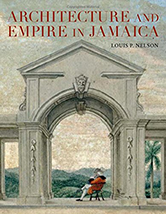 From the publisher:
From the publisher:
Through Creole houses and merchant stores to sugar fields and boiling houses, Jamaica played a leading role in the formation of both the early modern Atlantic world and the British Empire. Architecture and Empire in Jamaica offers the first scholarly analysis of Jamaican architecture in the long 18th century, spanning roughly from the Port Royal earthquake of 1692 to Emancipation in 1838. In this richly illustrated study, which includes hundreds of the author’s own photographs and drawings, Louis P. Nelson examines surviving buildings and archival records to write a social history of architecture.
Nelson begins with an overview of the architecture of the West African slave trade then moves to chapters framed around types of buildings and landscapes, including the Jamaican plantation landscape and fortified houses to the architecture of free blacks. He concludes with a consideration of Jamaican architecture in Britain. By connecting the architecture of the Caribbean first to West Africa and then to Britain, Nelson traces the flow of capital and makes explicit the material, economic, and political networks around the Atlantic.
Louis P. Nelson is professor of architectural history and associate dean for research in the School of Architecture, University of Virginia.
William E. O'Brien
Landscapes of Exclusion: State Parks and Jim Crow in the American South
University of Massachusetts Press, 2015
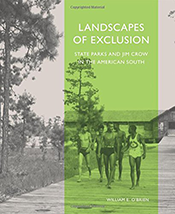 From the publisher:
From the publisher:
In the postwar years, as the NAACP filed federal lawsuits that demanded park desegregation and increased pressure on park officials, southern park agencies reacted with attempts to expand segregated facilities, hoping they could demonstrate that these parks achieved the “separate but equal” standard. But the courts consistently ruled in favor of integration, leading to the end of segregated state parks by the middle of the 1960s. Even though the stories behind these largely inferior facilities faded from public awareness, the imprint of segregated state park design remains visible throughout the South.
O’Brien illuminates this untold facet of Jim Crow history in the first-ever study of segregation in southern state parks. His new book underscores the profound inequality that persisted for decades in the number, size, and quality of state parks provided for African American visitors in the Jim Crow South.
William E. O’Brien is associate professor of environmental studies at the Harriet L. Wilkes Honors College of Florida Atlantic University.
Richard E. Strassberg and Stephen H. Whiteman
Thirty-Six Views: The Kangxi Emperor’s Mountain Estate in Poetry and Prints
Harvard University Press, 2016
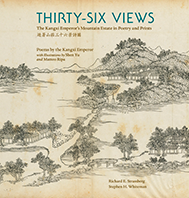 From the publisher:
From the publisher:
In 1712, the Kangxi emperor published Imperial Poems on the Mountain Estate for Escaping the Heat (Yuzhi Bishu shanzhuang shi) to commemorate his recently completed summer palace. Through his perceptions of thirty-six of its most scenic views, his poems and descriptions present an unusually intimate self-portrait of the emperor at the age of sixty that reflected the pleasures of his life there as well as his ideals as the ruler of the Qing Empire. Kangxi was closely involved in the production of the book and ordered several of his outstanding court artists – the painter Shen Yu and the engravers Zhu Gui and Mei Yufeng – to produce woodblock prints of the thirty-six views, which set a new standard for topographical illustration. He also ordered Matteo Ripa, an Italian missionary serving as a court-artist, to translate these images into the medium of copperplate engraving, which introduced this technique to China. Ripa’s hybridized interpretations soon began to circulate in Europe and influenced contemporary aesthetic debates about the nature and virtues of the Chinese garden. This artistic collaboration between a Chinese emperor and a western missionary-artist thus marked a significant moment in intercultural imagination, production, and transmission during an earlier phase of globalization.
Richard E. Strassberg is Professor of Chinese in the Department of Asian Languages and Cultures at the University of California, Los Angeles.
Stephen H. Whiteman is Lecturer in Asian Art at the University of Sydney.
Chip Sullivan
Cartooning the Landscape
The University of Virginia Press, 2016
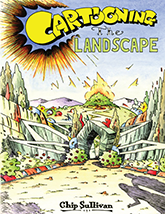 From the publisher:
From the publisher:
One of the singular talents in landscape design, Chip Sullivan has shared his expertise through a seemingly unusual medium that, at second glance, makes perfect sense – the comic strip. For years Sullivan entertained readers of Landscape Architecture Magazine with comic strips that ingeniously illustrated significant concepts and milestones in the creation of our landscapes. These strips gained a large following among architects and illustrators, and now those original works, as well as additional strips created just for this book, are collected in Cartooning the Landscape.
Framed by a loose narrative in which a young man’s search for wisdom is fulfilled by a comics shop owner who instructs him not only in the essentials of illustrating but in how to see, the book takes us on a whirlwind series of journeys. We visit the living sculptures of the Tree Circus on California’s Highway 17, the vast network of tunnels and fortifications – almost an underground city – of France’s Maginot Line, and take a trip through time that reveals undeniable parallels between the Emperor Hadrian’s re-creation of the Elysian Fields and, of all things, the iconic theme parks of Walt Disney. Sullivan immerses us in the artist’s concepts and tools, from the Claude mirror and the camera obscura to the role of optical illusion in art. He shows us how hot air balloons introduced aerial perspective and reveals exhibition effects that portended everything from Cinerama to Smell-O-Vision.
Sullivan’s book is also a plea, in an era increasingly dominated by digitally rendered images, for a new appreciation of the art of hand drawing. The proof of this craft’s value lies in the hundreds of Sullivan’s panels collected in this passionate, humorous, always illuminating tour of the rich landscape surrounding us.
Chip Sullivan is Professor of Landscape Architecture and Environmental Planning at the University of California, Berkeley. He is a winner of the Rome Prize and the author of the classic Drawing the Landscape, now in its fourth edition.
Jack Williams
Easy On, Easy Off: The Urban Pathology of America’s Small Towns
The University of Virginia Press, 2016
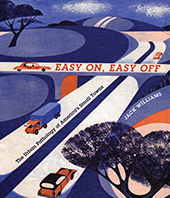 From the publisher:
From the publisher:
Life outside our nation’s big cities comprises a remarkably rich aspect of America – culturally, historically, and physically. Because of the way we move through the country, however – on roads built for maximum expediency – most of us are rarely if ever exposed to these small communities, a trend that is moving these towns dangerously far off the maps of commerce and public consciousness.
In Easy On, Easy Off, Jack Williams takes to the roads of the interstate highway system to explore America’s small towns, bringing back diverse examples of both beautiful and neglected places that illustrate how shifts in modern transportation have influenced urban form. Most of these communities are little known beyond their discrete regions, yet their struggles to prosper are universal. Mill towns, county-seat court squares, villages of the Great Plains, mining towns, and California's forgotten Chinese settlements all share similar fates – overshadowed by interstate off-ramp towns and bypassed by high-speed traffic.
Employing more than 150 historic maps and images, unique drawings, and contemporary photographs, Williams convincingly argues that irreversible changes have overtaken the landscapes of small-town America, with each community’s economic and social vitality slowly shifting away to other commercial places that attach to our highway interchanges and extrude into strip malls. A tale of success perhaps for the highway system, the more urgent story relayed in Easy On, Easy Off is of the loss of the complex fabric of thousands of small towns that once defined this nation.
Jack Williams is Emeritus Professor of Landscape Architecture at Auburn University and the author of East 40 Degrees: An Interpretive Atlas (Virginia).
